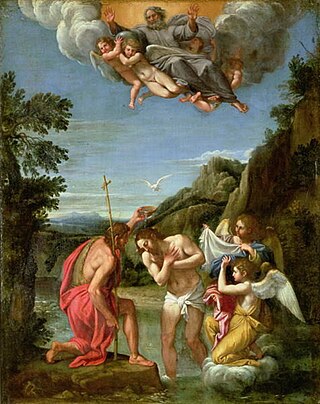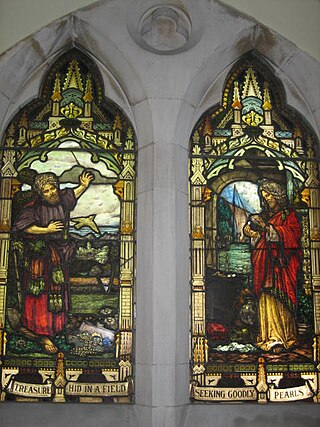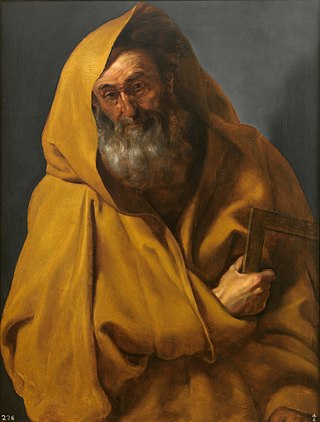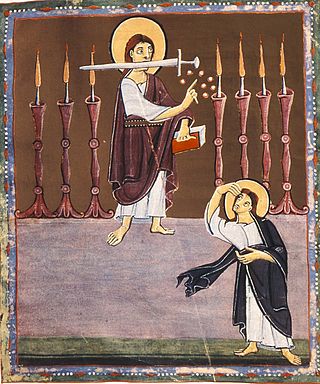
Adoptionism, also called dynamic monarchianism, is an early Christian nontrinitarian theological doctrine, which holds that Jesus was adopted as the Son of God at his baptism, his resurrection, or his ascension. How common adoptionist views were among early Christians is debated, but it appears to have been most popular in the first, second, and third centuries. Some scholars see adoptionism as the belief of the earliest followers of Jesus, based on the epistles of Paul and other early literature. However, adoptionist views sharply declined in prominence in the fourth and fifth centuries, as Church leaders condemned it as a heresy.

In Christianity, Christology, translated from Greek as 'the study of Christ', is a branch of theology that concerns Jesus. Different denominations have different opinions on questions such as whether Jesus was human, divine, or both, and as a messiah what his role would be in the freeing of the Jewish people from foreign rulers or in the prophesied Kingdom of God, and in the salvation from what would otherwise be the consequences of sin.

The Gospel of John is the fourth of the four canonical gospels. It contains a highly schematic account of the ministry of Jesus, with seven "signs" culminating in the raising of Lazarus and seven "I am" discourses culminating in Thomas' proclamation of the risen Jesus as "my Lord and my God". The gospel's concluding verses set out its purpose, "that you may believe that Jesus is the Christ, the Son of God, and that believing you may have life in his name."

John the Evangelist is the name traditionally given to the author of the Gospel of John. Christians have traditionally identified him with John the Apostle, John of Patmos, and John the Presbyter, although this has been disputed by most modern scholars.

The Parable of the Pearl is one of the parables of Jesus Christ. It appears in Matthew 13 and illustrates the great value of the Kingdom of Heaven.

The resurrection of Jesus is the Christian belief that God raised Jesus on the third day after his crucifixion, starting – or restoring – his exalted life as Christ and Lord. According to the New Testament writing, Jesus was firstborn from the dead, ushering in the Kingdom of God. He appeared to his disciples, calling the apostles to the Great Commission of forgiving sin and baptizing repenters, and ascended to Heaven.

John the Apostle or Saint John the Beloved was one of the Twelve Apostles of Jesus according to the New Testament. Generally listed as the youngest apostle, he was the son of Zebedee and Salome. His brother James was another of the Twelve Apostles. The Church Fathers identify him as John the Evangelist, John of Patmos, John the Elder, and the Beloved Disciple, and testify that he outlived the remaining apostles and was the only one to die of natural causes, although modern scholars are divided on the veracity of these claims.

A tetramorph is a symbolic arrangement of four differing elements, or the combination of four disparate elements in one unit. The term is derived from the Greek tetra, meaning four, and morph, shape.

Jesus is called the Son of God in the Bible's New Testament, and in mainstream Christian denominations he is God the Son, the second Person in the Trinity. He is believed to be the Jewish messiah who is prophesied in the Hebrew Bible, which is called the Old Testament in Christianity. Through his crucifixion and subsequent resurrection, God offered humans salvation and eternal life, that Jesus died to atone for sin to make humanity right with God.

In Christian tradition, the Four Evangelists are Matthew, Mark, Luke, and John, the authors attributed with the creation of the four canonical Gospel accounts. In the New Testament, they bear the following titles: the Gospel of Matthew; the Gospel of Mark; the Gospel of Luke; and the Gospel of John. These names were assigned to the works by the early church fathers in the 2nd century AD; none of the writers signed their work.

Form criticism as a method of biblical criticism classifies units of scripture by literary pattern and then attempts to trace each type to its period of oral transmission. "Form criticism is the endeavor to get behind the written sources of the Bible to the period of oral tradition, and to isolate the oral forms that went into the written sources. Insofar as this attempts to trace the history of the tradition, it is known as tradition criticism." Form criticism seeks to determine a unit's original form and the historical context of the literary tradition.

The Parable of the Ten Virgins, also known as the Parable of the Wise and Foolish Virgins or the Parable of the ten bridesmaids, is one of the parables of Jesus. According to Matthew 25:1-13, ten virgins await a bridegroom; five have brought enough oil for their lamps for the wait, while the oil of the other five runs out. The five virgins who are prepared for the bridegroom's arrival are rewarded, while the five who went to buy further oil miss the bridegroom's arrival and are disowned.
The Parable of the Unjust Steward or Parable of the Penitent Steward is a parable of Jesus which appears in Luke 16:1–13. In it, a steward who is about to be fired tries to "curry favor" with his master's debtors by remitting some of their debts. The term "steward" is common in many English translations of the New Testament; some versions refer to a "manager", or an "accountant". This parable does not appear in the other gospels.

Richard John Bauckham is an English Anglican scholar in theology, historical theology and New Testament studies, specialising in New Testament Christology and the Gospel of John. He is a senior scholar at Ridley Hall, Cambridge.

James, son of Alphaeus was one of the Twelve Apostles of Jesus, appearing under this name in all three of the Synoptic Gospels' lists of the apostles. He is generally identified with James the Less and commonly known by that name in church tradition. He is also labelled "the Minor", "the Little", "the Lesser", or "the Younger", according to translation. He is distinct from James, son of Zebedee and in some interpretations also from James, brother of Jesus. He appears only four times in the New Testament, each time in a list of the twelve apostles.

Christian theology sometimes refers to Jesus using the title Redeemer. This refererences the salvation he accomplished, and is based on the metaphor of redemption, or "buying back". In the New Testament, redemption can refer both to deliverance from sin and to freedom from captivity.

Son of man is an expression in the sayings of Jesus in Christian writings, including the Gospels, the Acts of the Apostles and the Book of Revelation. The meaning of the expression is controversial. Interpretation of the use of "the Son of man" in the New Testament has remained challenging and after 150 years of debate no consensus on the issue has emerged among scholars.

Christology: A Biblical, Historical, and Systematic Study of Jesus is a 2009 theological book by the Australian Jesuit priest and academic Gerald O'Collins. This work was originally published in 1995 with the title Christology: A Biblical, Historical, and Systematic Study of Jesus Christ, but the author thoroughly revised the whole text in 2009 to take account of the numerous biblical, historical, and systematic studies of Jesus that appeared following its first edition.
The Lord is a Christological book by Romano Guardini, a Roman Catholic priest and academic. It was first published in Germany in 1937 by Werkbund-Verlag, and an English-language translation was published in 1954 by Henry Regnery Company.

The Jesus I Never Knew is a popular 1995 Christological book by the American Christian author Philip Yancey. It won the Gold Medallion Book Award and ECPA Christian Book of the Year 1996: it is a book that appeals to the wider Christian public for its personal approach to the figure of Jesus, with a fresh and vivid portrayal extracted from a dynamic reading of the four canonical gospels.


















